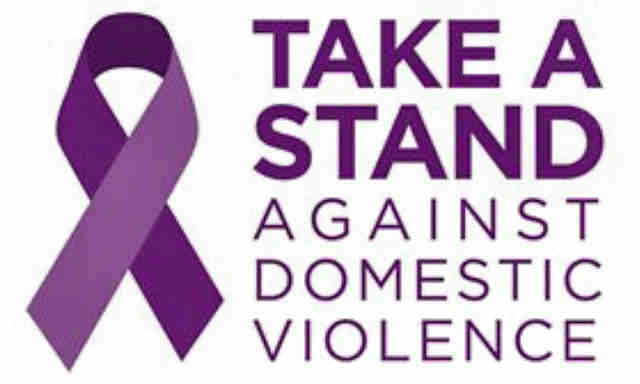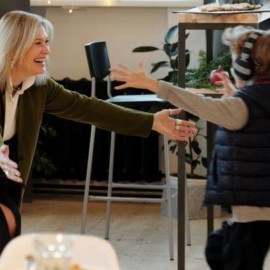
PUBLISHER’S NOTE: This blog is as meaningful today as it was when we originally posted it on October 14, 2017. October is Domestic Violence Awareness Month. We have listed links to resources and past blog articles to assist those in need during the 2020 Covid-19 pandemic. Let’s all do our part to help erase domestic violence everywhere in our world!
10 Tips to Have an Informed Conversation About Domestic Violence
October is domestic violence awareness month. Unfortunately, at one time or another we have all come across situations of domestic violence . As a divorce lawyer, I see examples of its tragic effects all the time. In Dayton we are very fortunate to have the Artemis House resource to assist victims of domestic violence!
In order to help spread ddomestic violence awareness about this terrible situation, I have posted below the “10 Tips to Have an Informed Conversation About Domestic Violence” published by the National Network to End Domestic Violence (NNEDV) https://nnedv.org/. Also, at the end of this article, I have share links to some of the prior articles we have published on this topic on the Ohio Family Law Blog in the past. Let’s all do our part to help eradicate domestic violence throughout society!
- NEVER victim blame.Abuse is never the victim’s fault. As a society, we continue to place blame on victims by asking, “What did she do to deserve that?” or “What was she wearing?” or “Why was she there?” or “Why couldn’t she just keep her knees together?” Yet we do not ask these questions to victims of other crimes. We must stop asking these questions of domestic violence and sexual assault survivors.ASK: How can we shift the culture away from blaming the victim and instead blame the perpetrator? Why does the abuser choose the abuse?
RESPOND: Believe, support, and trust survivors. Instead of second guessing their experiences, let’s rightfully place the responsibility on abusers and perpetrators to end the abuse. Domestic violence is rooted in power and control.
- Hold offenders accountable.Holding offenders accountable can take many forms. If it is safe to do so, call offenders out on their abusive actions and impose social consequences, like telling them they’re not welcome for family dinner or to hang out until the abusive behavior stops. Stop excusing behavior with “boys will be boys” or “[the perpetrator] would never do something like that”. Community accountability can make a significant impact.ASK: How can we hold offenders accountable and support survivors?
RESPOND: Tell the perpetrator that their behavior is abuse. Healthy relationships are rooted in equality, respect, and nonviolence.
- Challenge widely-held perceptions about domestic violence.Unfortunately, misconceptions about domestic violence persist, such as the notions that survivors can “just leave”; that heterosexual, cisgender women are the only victims; that domestic violence only includes physical violence; or, that domestic violence is a “private, family matter”. Each one of these myths persists, despite our work to challenge these perceptions. Through NNEDV’s #31n31 campaign in October 2016, we busted several of these myths – check out the full campaign on Pinterest.ASK: Why can’t survivors “just leave”? Other than physical violence, what other forms of abuse can domestic violence take?
RESPOND: Survivors must think about their own physical safety, financial security, the safety and welfare of their children and pets, potential housing and where they can “just leave” to, among a myriad of other issues. Domestic violence can include physical, financial, emotional, psychological, or sexual abuse.
- Voice that domestic violence is an intersectional issue.Domestic violence does not happen in a vacuum. Survivors experiencing domestic violence often experience other “–isms” (e.g., sexism, racism, classism, heteronormativism, etc.), compounding negative impacts on victims. Collectively, these –isms play a devastating role in perpetuating gender-based violence. In 2016, a study was released that found that there is racial bias in media coverage of celebrity domestic violence.ASK: How do you think different oppressions and privileges affect survivors’ experiences?
RESPOND: When coupled with other –isms, victims face additional barriers to safety.
- Understand that abuse is rooted in power and control.Abuse is intentional. It is a myth that someone who abuses their partner is “out of control”. In fact, they are in good control (how often do they “lose control” at work? With a friend? With other family members?) and purposely choose tactics to control their partner. Power is hard to give up or share and abusive actions are purposeful with the goal of gaining power and control over a partner.ASK: What do you think are common ways that offenders use power and control over victims?
RESPOND: Strategically isolating victims is a common tactic to gain power and control over a victim. Perpetrators may trap their partners by withholding, lying about, or hiding financial assets, a form of financial abuse.
- Trust the survivor’s perspective.Survivors know their experience and story better than anyone. Taking a survivor-centered approach empowers survivors by prioritizing their needs and wants. Often, abusers deny their partners’ self-determination; empowering survivors returns their control and enables them to make their own decisions.ASK: In what ways can we support survivors in making their own decisions about how to address abuse?
RESPOND: Listen! Ask survivors what they need to individually be safe – there is no one-size-fits-all approach to addressing domestic violence.
- Question the way the media portrays domestic violence.Within the last few years there have been a number of highly publicized cases of domestic violence. While raising awareness is important, it’s crucial to look at domestic violence reporting through a critical and trauma-informed lens to make sure the portrayal of domestic violence is accurately rooted in the realities of survivors’ experiences.ASK: What have you thought about recent media coverage of celebrity domestic violence cases?
RESPOND: Survivors in highly publicized cases deserve the same respect as any person experiencing abuse. First and foremost, we must believe survivors, continue to hold celebrity offenders accountable, and keep in mind that everyone’s story is their own and unique.
- Communicate that domestic violence is not a “private, family matter”.One in three women will be a victim of domestic or sexual violence at some point in her lifetime and each day an average of three women die at the hands of someone who claimed to love them. Domestic violence affects us all; victims are our family members, neighbors, coworkers, and friends. All of us – women, children, and men – must be part of the solution.ASK: Do you know anyone who has been affected by domestic violence? How did you support them?
RESPOND: Domestic violence affects each and every one of us. Violence is not the answer and it’s on us to take a stand against domestic violence.
- Root your conversation in equality.One of the root causes of domestic violence is inequality. Addressing this root cause takes conscious action and significant social change.ASK: What role does gender inequality play in domestic violence?
RESPOND: Many dynamics of power and control are rooted in gender roles and stereotypes. One way to combat these ingrained inequalities is through conscious action (e.g., by calling out sexism, racism, or any other –ism when you see it) and youth education.
- Remember domestic violence affects all of us, but with action and education we can end it.Domestic violence is everywhere, affecting millions of individuals across the United States regardless of age, economic status, race, ethnicity, gender, sexual orientation, religion, or education. Domestic violence is not strictly physical abuse, but can include emotional, financial, verbal, psychological, sexual, and technology-facilitated abuse as well.ASK: What can you do to end domestic violence?
RESPOND: There are many ways to help end domestic violence (here are 31 ideas)! The easiest way is to start a conversation about domestic violence with your loved ones. Support your community by volunteering or donating to a domestic violence organization. Learn more about getting involved at NNEDV.org/GetInvolved.
IF YOU’RE HAVING A CONVERSATION ABOUT DOMESTIC VIOLENCE AND SOMEONE DISCLOSES THAT THEY ARE A VICTIM OR SURVIVOR OF DOMESTIC VIOLENCE, YOU CAN:
- Listen, and communicate that the abuse they’re experiencing is not their fault. Let them know that they deserve safety and respect.
- Refer them to resources:
If they are in immediate danger, please call 911, a local hotline, or the U.S. National Domestic Violence Hotline at (800) 799-7233 and TTY (800) 787-3224.
- Learn more about domestic violence from NNEDV.org.
- Find your state or territory coalition at NNEDV.org/Coalitions.
- Learn more about technology-facilitated abuse, harassment, and harm from TechSafety.org
- Learn more about laws and legal remedies from WomensLaw.org.
Here are some links to past articles published about domestic violence on the Ohio Family Law Blog:
- Protection Order: Proving Domestic Violence in a Court of Law can be Difficult
- Domestic Violence within Military Families Probable Says Study
- Artemis Center: Dayton’s Domestic Violence Resource Agency
- Artemis Center – An Update
- The Pros and Cons of Victims of Domestic Violence Changing Their Identity
Here is the HOTLINE EMERGENCY PHONE NUMBER to the Artemis Center in Dayton: 937 461-HELP (4357)
Did you like this article on domestic violence awareness? To read more articles like this and others, please use the search box below.
© 2020, Ohio Family Law Blog. All rights reserved.

Attorney Robert “Chip” Mues has been focusing his legal practice throughout Southwest Ohio primarily in divorce and family law matters since 1978. Chip is passionate about family law and has proudly published the Ohio Family Law Blog since 2007. In addition, he previously managing the Dayton law firm of Holzfaster, Cecil, McKnight & Mues LPA until it dissolved on December 31, 2024. He recently has founded MUESLAW in 2025. To learn more about him or MUESLAW, visit www.MuesLaw.com. Appointments are available in person, over the phone or by Zoom. Call us at 937 293-2141.





